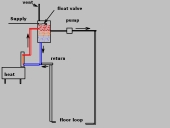A combination of a rocket-type stove and
solar trough/solar oven is what I would prefer to work with, for active and passive heating.
I have a great stove we built to accept modular add-ons. It's a
rocket stove with what we believe are improvements, like an automatic fuel
feed system and a secondary air intake in the flue. It outperforms the original
rocket stove we built, so we're doing something right with it. Since we built it to accept modular units that stack at the flue, we want to try to get the stove to serve many uses as possible.
Hot water/oil heater, cooktop with stove, gasifier, ect... Generating electricity in various ways is a big goal of ours.
I can't seem to get away from a steam add-on, though we're already working with gasification. We're considering using a monotube boiler to run a Tesla Turbine, but I'm exploring other possible options as well, if any are viable and user friendly.
The generator we'll be turning is a Lenzless type we built; very little HP required as we're rotating laminated shields between stationary coils and stationary magnets. We hope to adapt it to a small wind turbine and we're trying to figure out the best way to get the stove and/or
solar heat to turn it as well. We're fairly proud of the stove and we think folks will find it useful, but we believe this generator will be a real game changer down the line. All open sourced.
I read about an early steam driven water pump that had no pistons. I think it predated the piston steam engine, but I can't vouch for that as I'm relying on my memory alone. Having a hard time finding it again on google. It vented the steam into the water, and it used two chambers, one for steam pressure, the other to create a vacuum as steam condensed, if I remember correctly. Both chambers contributed to lifting the water.
We'd be very interested in a way to use heat to raise water, as well. Any suggestions or info would be welcome.












































